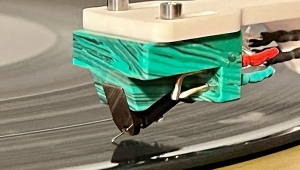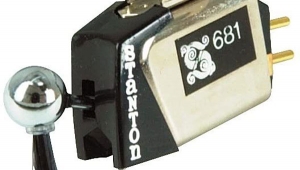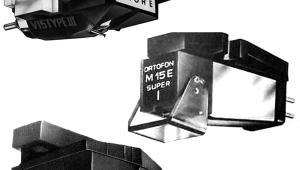| Columns Retired Columns & Blogs |
ZYX R-1000 Airy S phono cartridge
My wife and I have this ongoing riff: We try to make each other laugh by sharing examples of words we've looked at too quickly and misread—mistaking offered for overfed, bagel for kegel, that sort of thing. All very subtle and dry and Garrison Keillor. You can hear the belly laughs from there, can't you?
 I mention this because of the mistake I made when I first opened the shipping carton from Bertrand Audio and saw this cartridge's packaging, which is prominently adorned with the words airy sound. I misread that as hairy sound, and, without waiting for correction, my brain tried to determine what such a thing might mean. It could not.
I mention this because of the mistake I made when I first opened the shipping carton from Bertrand Audio and saw this cartridge's packaging, which is prominently adorned with the words airy sound. I misread that as hairy sound, and, without waiting for correction, my brain tried to determine what such a thing might mean. It could not.
The packaging for the ZYX R-1000 Airy S also suggested, in similarly large print, that the cartridge had been cryogenically treated. (ZYX is the name of the company, R-1000 refers to this series of cartridges in their product line, and Airy S is the name of the specific model reviewed.) Working together, my brain and the Internet had an easier time determining what that means. I used Google to do a search on the words cryogenically treated. The first 10 things that came up were:
1) vacuum tubes
2) guns
3) scientific research
4) trumpets
5) trumpets again
6) automobile parts
7) more automobile parts
8) musical instruments (in general)
9) baseball bats (but not baseball players)
10) coal-mining equipment
(That last one was a link to another Primedia publication, Coal Age. Small world.)
It's interesting that the No.1 response to a search based on a technology that most Americans have at least heard of has to do with perfectionist audio: Perhaps we're on our way to being demarginalized. With the possible exception of the scientific researchers (those guys give me the creeps), we also appear to be in very good company.
Move over, Mrs. Paul
I've also learned that cryogenic treatment, as it pertains to metals, is a process in which an object is cooled to some temperature below -300 degreesF, at which point impurities are "precipitated out." Small complex carbides vanish, the martensites drive out the austenites (sounds biblical, and not just because both rhyme with smites), and, all in all, the metal under treatment becomes purer, smoother, and less open in its grain structure.
A great many obvious, unambiguous, and irreversible real-world improvements have been reported as a result of these microscopic changes. Drill bits become sharper, and stay sharper longer. Bearing components become smoother and less subject to wear. Conductors become more conductive (could it help Previn's Mahler, I wonder?), magnets more magnetic. One very credible study showed that cryogenically treated brake rotors and other automotive components last up to 400% longer than untreated parts. (Some professional race-car drivers say their entire drivetrains are cryogenically treated, and that's how they like it. On the other hand, these same drivers have been known to suggest that they use Skoal smokeless tobacco products and drink Mountain Dew. I'll leave it to you whether there's a little credibility problem there or not.)
All of which brings us back to the Hairy: This is the first product I've reviewed that contains cryogenically treated parts (that I know of). Specifically, the parts treated are the terminal pins, rear yoke, front yoke, pole piece, coils, and armature. Hisayoshi Nakatsuka, president of ZYX Corporation of Japan, suggests that cryogenically treating those parts contributes to his product's clear, pure, dynamic sound.
Other aspects of this cartridge interest me as well. The coils are drawn from silver wire that is of unusual purity even before being cryogenically treated. For long life and linear action, a very pure elastomer has been chosen for the damper—an area of research in which Mr. Nakatsuka has specialized since the mid-1980s, when he developed the Alpha Genesis series of cartridges for Monster Cable. The Airy S uses a very small (3µm by 6µm) Micro-Ridge stylus for improved noise and wear characteristics.
The thing I find most intriguing of all—especially in light of my recent experiences with Denis Morecroft and his DNM electronics (see "Listening" in this issue, and in April 2003)—is the fact that the ZYX R-1000 Airy S is housed in a clear acrylic body, to prevent eddy currents from interfering with its output signal.
I'll highlight those of the Airy's specs that have the greatest bearing on component matching. The fact that the motor is somewhat more compliant in the horizontal plane than in the vertical is not all that unusual—Decca cartridges, which have always intrigued me, take this disparity to an extreme. It does, however, seem to mitigate against the use of an air-bearing or other "mechanical" linear-tracking arm, which would prefer the opposite. The distance between the Airy's stylus tip and the centerline of its mounting bolts is such that the correct overhang is easy to achieve in the non-adjustable Naim Aro tonearm—or at least it was on my Linn LP12 with the standard Naim-sourced Aro armboard. The Airy's lowish coil impedance should be kept in mind by anyone whose moving-coil step-up transformer offers a choice of different primaries. And the fact that the Airy weighs only 5gm may pose a practical and sonic challenge when trying to mount and balance it in a tonearm that expects something heavier.
Listening
This time out, my performance observations are even more context-specific than usual.
First, you should know that I had the Airy S cartridge in my system twice as long—an unconscionable six months—as I usually keep review samples. In doing so, I tried the importer's patience, which I regret.
I not only kept the Airy S longer than usual, I used it with a greater number and greater variety of associated components than usual. I installed it in three tonearms: my usual Naim Aro, a Linn Ekos, and a Rega RB300, using a full complement of WallyTools to set it up in the latter two arms. I used three different turntables: two Linn LP12s and a Rega Planar 3.
I ran the Airy S direct into three different active phono preamps: the unearthly quiet Linn Linto; the EAR 324, which is even more extraordinary, albeit in different ways; and the MC input of the Naim 32.5. I used it with every combination possible of two different moving-coil step-up transformers—the Audio Note AN-S2 and the Tamura TKS-83—in concert with the phono stages of four different "full-function" preamplifiers: my own Fi, plus Audio Note's M2 Phono and M3 Phono, and Cary's SLP-98P. Beyond all that, I used every pair of speakers I own (both of 'em!), each of the three amps I own (Fi 2A3 Stereo, Audio Note Kit One, Naim 110), plus everything else that came in the door not so suddenly since summer.
Having tried all that, I feel pretty confident in suggesting that the ZYX R-1000 Airy S is the most tonally neutral moving-coil cartridge I've ever heard. In fact, the way I found myself thinking of the Airy S after a couple of months—by which time it should have been on its way back to New Hampshire—was that it sounded like a Shure V15 Type whatever, except it was more dramatic and involving than our friend from Evanston ever was.
Some of you will say, Stop there: This is the thing I want. That's fine. As I think I've made abundantly clear over the past few months, the choice of precisely which sonic attributes to weigh most heavily is your choice alone—and, in fact, if tonal/timbral neutrality is the most important thing to you, you're in fine company, if nothing else.
But a genuinely neutral domestic audio component of any sort is one of the most difficult things in the world to write about or even describe. I could kill a thousand words—slowly, painfully—giving you examples of how the ZYX didn't sound bright, didn't sound lumpy, whatever. That would get very old very fast. It would be easier on both of us if you take my word.
- Log in or register to post comments



































